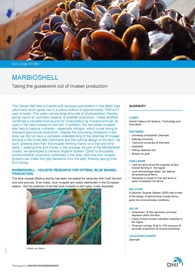MarBioShell - Taking the guesswork out of mussel production
The Danish Belt Sea is flushed with excess precipitation in the Baltic Sea catchment. This water carries large amounts of phytoplankton, thereby giving rise to an unlimited capacity of shellfish production.
 The Danish Belt Sea is flushed with excess precipitation in the Baltic Sea catchment. This water carries large amounts of phytoplankton, thereby giving rise to an unlimited capacity of shellfish production. These shellfish are a valuable food source for consumption by humans and can be used in fish feed instead of wild fish.
The Danish Belt Sea is flushed with excess precipitation in the Baltic Sea catchment. This water carries large amounts of phytoplankton, thereby giving rise to an unlimited capacity of shellfish production. These shellfish are a valuable food source for consumption by humans and can be used in fish feed instead of wild fish.
Despite the promising conditions in the area, we did not have a complete understanding of the potential of mussel farming in the Great Belt (Denmark) and the optimal design of the farm. As such, growers have been planning their line-mussel farming mainly on a trial and error basis – wasting time and money in the process.
As part of the MarBioShell project, we developed a Decision Support System (DSS) to accurately predict shellfish production potentials in the area. With this tool, mussel growers can make the right decisions from the start, thereby saving time and money.
Read more